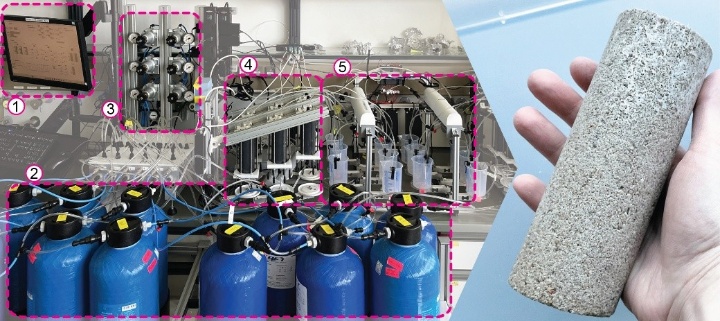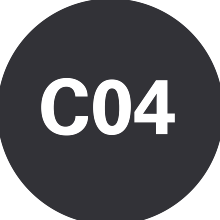People
Publications
Preprints
- Bozkurt, K., Lohrmann, C., Weinhardt, F., Hanke, D., Hopp, R., Gerlach, R., Holm, C., & Class, H. (2025). Intermittent flow paths in biofilms grown in a microfluidic channel. In arXiv preprint arXiv:2504.00062. https://doi.org/10.48550/arXiv.2504.00062
- Kohlhaas, R., Hommel, J., Weinhardt, F., Class, H., Oladyshkin, S., & Flemisch, B. (2025). Numerical Investigation of Preferential Flow Paths in Enzymatically Induced Calcite Precipitation supported by Bayesian Model Analysis. In arXiv preprint arXiv:2503.17314. https://doi.org/10.48550/arXiv.2503.17314
(Journal-) Articles
- Krach, D., Weinhardt, F., Wang, M., Schneider, M., Class, H., & Steeb, H. (2025). A novel geometry-informed drag term formulation for pseudo-3D Stokes simulations with varying apertures. Advances in Water Resources, 195. https://doi.org/10.1016/j.advwatres.2024.104860
- Lee, D., Weinhardt, F., Hommel, J., Piotrowski, J., Class, H., & Steeb, H. (2023). Machine learning assists in increasing the time resolution of X-ray computed tomography applied to mineral precipitation in porous media. Scientific Reports, 13. https://doi.org/10.1038/s41598-023-37523-0
- Hommel, J., Gehring, L., Weinhardt, F., Ruf, M., & Steeb, H. (2022). Effects of Enzymatically Induced Carbonate Precipitation on Capillary Pressure-Saturation Relations. Minerals, 12. https://doi.org/10.3390/min12101186
- Weinhardt, F., Deng, J., Hommel, J., Dastjerdi, S. V., Gerlach, R., Steeb, H., & Class, H. (2022). Spatiotemporal Distribution of Precipitates and Mineral Phase Transition During Biomineralization Affect Porosity-Permeability Relationships. Transport in Porous Media, 143, 527–549. https://doi.org/10.1007/s11242-022-01782-8
- Class, H., Bürkle, P., Sauerborn, T., Trötschler, O., Strauch, B., & Zimmer, M. (2021). On the Role of Density-Driven Dissolution of CO2 in Phreatic Karst Systems. Water Resources Research, 57, Article 12. https://doi.org/10.1029/2021wr030912
- von Wolff, L., Weinhardt, F., Class, H., Hommel, J., & Rohde, C. (2021). Investigation of Crystal Growth in Enzymatically Induced Calcite Precipitation by Micro-Fluidic Experimental Methods and Comparison with Mathematical Modeling. Transport in Porous Media, 137, 327–343. https://doi.org/10.1007/s11242-021-01560-y
- Wagner, A., Eggenweiler, E., Weinhardt, F., Trivedi, Z., Krach, D., Lohrmann, C., Jain, K., Karadimitriou, N., Bringedal, C., Voland, P., Holm, C., Class, H., Steeb, H., & Rybak, I. (2021). Permeability Estimation of Regular Porous Structures: A Benchmark for Comparison of Methods. Transport in Porous Media, 138, 1–23. https://doi.org/10.1007/s11242-021-01586-2
- Weinhardt, F., Class, H., Dastjerdi, S. V., Karadimitriou, N. K., Lee, D., & Steeb, H. (2021). Experimental Methods and Imaging for Enzymatically Induced Calcite Precipitation in a Microfluidic Cell. Water Resources Research, 57. https://doi.org/10.1029/2020wr029361
- Emmert, S., Class, H., Davis, K., & Gerlach, R. (2020). Importance of specific substrate utilization by microbes in microbially enhanced coal-bed methane production: A modelling study. International Journal of Coal Geology, 229. https://doi.org/10.1016/j.coal.2020.103567
- Emmert, S., Davis, K., Gerlach, R., & Class, H. (2020). The Role of Retardation, Attachment and Detachment Processes during Microbial Coal-Bed Methane Production after Organic Amendment. Water, 12. https://doi.org/10.3390/w12113008
- Hommel, J., Akyel, A., Frieling, Z., Phillips, A., Gerlach, R., Cunningham, A. B., & Class, H. (2020). A Numerical Model for Enzymatically Induced Calcium Carbonate Precipitation. Applied Sciences, 10, Article 13. https://doi.org/10.3390/app10134538
- Beck, M., & Class, H. (2019). Modelling fault reactivation with characteristic stress-drop terms. Advances in Geosciences, 49, 1–7. https://doi.org/10.5194/adgeo-49-1-2019
- Cunningham, A. B., Class, H., Ebigbo, A., Gerlach, R., Phillips, A. J., & Hommel, J. (2018). Field-scale modeling of microbially induced calcite precipitation. Computational Geosciences, 23, 399–414. https://doi.org/10.1007/s10596-018-9797-6
- Hommel, J., Coltman, E., & Class, H. (2018). Porosity-Permeability Relations for Evolving Pore Space: A Review with a Focus on (Bio-)geochemically Altered Porous Media. Transport in Porous Media, 124, 589–629. https://doi.org/10.1007/s11242-018-1086-2
- Hommel, J., Lauchnor, E., Phillips, A., Gerlach, R., Cunningham, A. B., Helmig, R., Ebigbo, A., & Class, H. (2015). A revised model for microbially induced calcite precipitation: Improvements and new insights based on recent experiments. Water Resources Research, 51, Article 5. https://doi.org/10.1002/2014WR016503
Published data sets
- Krach, D., Weinhardt, F., Wang, M., Schneider, M., Class, H., & Steeb, H. (2024). Results for pseudo-3D Stokes simulations with a geometry-informed drag term formulation for porous media with varying apertures [DaRUS]. https://doi.org/10.18419/DARUS-4347
- Krach, D., Weinhardt, F., Wang, M., Schneider, M., Class, H., & Steeb, H. (2024). Code and benchmarks for geometry-informed drag term computation for pseudo-3D Stokes simulations with varying apertures [DaRUS]. https://doi.org/10.18419/DARUS-4313
- Lee, D., & Steeb, H. (2023). Image enhancement code: time-resolved tomograms of EICP application using 3D U-net [DaRUS]. https://doi.org/10.18419/DARUS-2991
- Lee, D., Weinhardt, F., Hommel, J., Class, H., & Steeb, H. (2023). Time resolved micro-XRCT dataset of Enzymatically Induced Calcite Precipitation (EICP) in sintered glass bead columns [DaRUS]. https://doi.org/10.18419/DARUS-2227
- Hommel, J., & Gehring, L. (2022). Enzymatically induced carbonate precipitation and its effect on capillary pressure-saturation relations of porous media - column samples [DaRUS]. https://doi.org/10.18419/DARUS-1713
- Hommel, J., & Weinhardt, F. (2022). Enzymatically induced carbonate precipitation and its effect on capillary pressure-saturation relations of porous media - microfluidics samples [DaRUS]. https://doi.org/10.18419/DARUS-2791
- Ruf, M., Hommel, J., & Steeb, H. (2022). Enzymatically induced carbonate precipitation and its effect on capillary pressure-saturation relations of porous media - micro-XRCT dataset of high column (sample 4) [DaRUS]. https://doi.org/10.18419/DARUS-2907
- Ruf, M., Hommel, J., & Steeb, H. (2022). Enzymatically induced carbonate precipitation and its effect on capillary pressure-saturation relations of porous media - micro-XRCT dataset of low column (sample 10) [DaRUS]. https://doi.org/10.18419/DARUS-2908
- Ruf, M., Hommel, J., & Steeb, H. (2022). Enzymatically induced carbonate precipitation and its effect on capillary pressure-saturation relations of porous media - micro-XRCT dataset of medium column (sample 3) [DaRUS]. https://doi.org/10.18419/DARUS-2906
- Weinhardt, F., Deng, J., Steeb, H., & Class, H. (2022). Optical Microscopy and log data of Enzymatically Induced Calcite Precipitation (EICP) in microfluidic cells (Quasi-2D-structure) [DaRUS]. https://doi.org/10.18419/DARUS-1799
Research
About this Project
Porosity and permeability are two major hydraulic properties that govern flow through porous media, while there are different processes in many different fields of applications that can cause pore space to evolve due to fluid-solid phase change. For the time being, this project puts a focus on induced calcite precipitation as an engineering option for targeted sealing of flow pathways in porous media or for targeted improvement of soil strength. Noteworthy, hydraulic alterations due to calcite precipitation are inseparable from mechanical alterations. While our primary focus is first of all on the experimental observation of the hydraulic alterations in terms of porosity-permeability relations due to growth of carbonates in the pore space, we plan to address later on also the topic of mechanical alterations.
Results
Funding Period 1
In the first funding period, the project has focused on experimental EICP (enzyme-induced calcite precipitation) in microfluidic cells. Setups and imaging techniques (microscopy, XRCT) were developed to analyze pore-space changes as seen in Figure 1 and to link calcite precipitation to permeability alterations via pressure monitoring as seen in Figure 2. Analyzing precipitation patterns in pore throats and bodies is crucial for deriving porosity-permeability relationships from morphological changes. This requires a reliable workflow to produce and observe reproducible patterns. Quasi-1D setups differ from 2D ones, where flow can bypass obstructions more easily. Experimental work was done in close cooperation with the external partner at the Center for Biofilm Engineering, Montana State University, Bozeman. Modelling-supported interpretation of microfluidic precipitation experiments was done in collaboration with research project C02.
Funding Period 2
During FP 2, the project investigated how enzyme-induced (EICP) and microbially induced (MICP) calcium carbonate precipitation compare in microfluidic cells with respect to precipitation patterns and porosity-permeability relations. Furthermore, biofilm formation was studied under shear as seen in Figure 3 and in the Video 2 in a collaboration with research project C01, affect pore structure and hydraulic behavior. Porosity-permeability relationships were mainly analyzed in microfluidic systems through imaging and numerical simulations. The comparison of EICP and MICP, along with different cementation strategies, showed that boundary conditions—such as forced flow versus constant pressure—are particularly critical near injection zones. Additionally, the evolution of mechanical properties in porous media was studied numerically to support future research directions. Also in FP2, we have strongly involved the external partner from MSU Bozeman in the experimental work and interpretation of results.
We have developed with research project B05 and the project INF (M. Schneider) computationally efficient pore-scale Stokes model, which can be used to analyze the microfluidic results with respect to permeability and its anisotropy. Furthermore, we work with research project C05 on the comparison between our microfluidic calcite precipitation and their experimental approaches on the REV scale with small cylindrical cores.
The project has also contributed to the FP2 vision topic ‘’calcite dissolution’’ by investigating CO2-dependent driving forces for calcite dissolution in karstic systems.

Future Work
All research activities within this project are closely aligned with the CRC-wide vision topic “salt.” A central objective is to enhance conceptual modelling approaches at the REV scale for bio-concrete production using microbially induced calcium carbonate precipitation (MICP). In doing so, we aim to benefit from the mechanistic, less phenomenological modelling strategies developed in related sub-projects such as C01 and B01.
The project will focus on the strong coupling between hydraulic and mechanical property changes in porous media during MICP-based bio-concrete formation by using the experimental setup as seen in Figure 4. Particular emphasis will be placed on validating and parameterizing a constant-cement model that links porosity changes to stiffness. This effort will rely on experimental data obtained from C04, B05, and Z02. Another major goal is to establish numerical simulation as a key tool in optimizing bio-concrete production processes, by developing reliable workflows and refining experimental setups in line with principles of experimental design. Furthermore, an open question from earlier project phases—concerning the differing behaviour of MICP in glass versus PDMS microfluidic cells—will be addressed in close collaboration with research project Z02.

International Cooperation
There has been a long-standing collaboration between the work groups of Holger Class and Rainer Helmig in Stuttgart and the group of Robin Gerlach and Al Cunningham at Montana State University. The intensive scientific exchange resulted in a number of high-ranked joint publications.
In the Biofilm Center at MSU Bozeman, there is an outstanding experimental facility which will be of great use for research project C04. Altogether, within SFB 1313 the successful joint research is expected to be continued.
For further information please contact

Holger Class
apl. Prof. Dr. Ing.Project Leader, Research Project C04, Central Project Z





